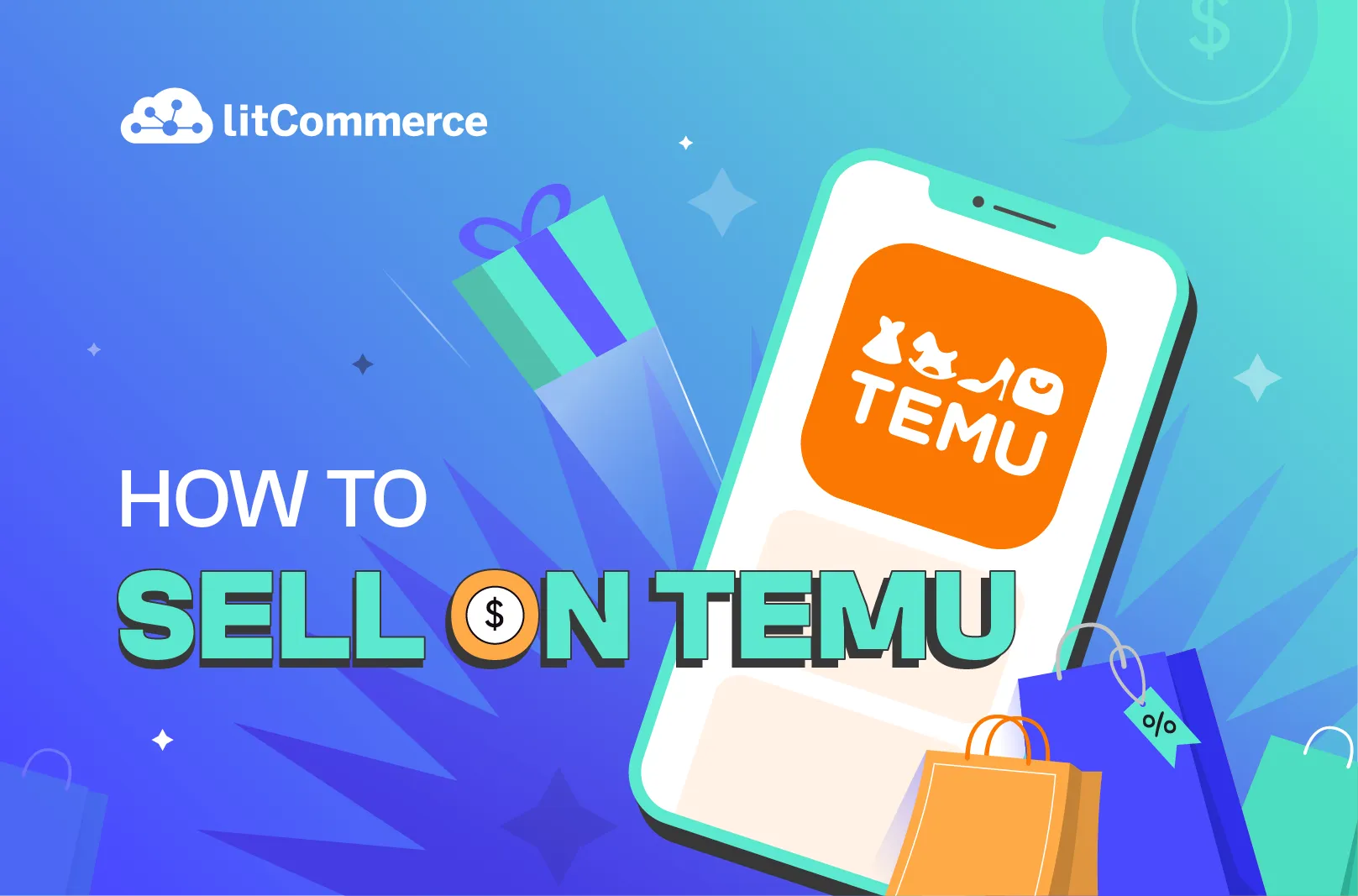If you’re wondering how to sell on Temu, you’ve come to the right place.
Launched in the US in 2022, Temu has quickly become one of the fastest-growing eCommerce platforms. In 2024, its online store, Temu.com, generated an impressive US$53.9 billion in sales, a staggering 280–285% increase from the previous year. That same year, Temu was also the most downloaded shopping app globally.
As a thriving global marketplace, Temu offers significant earning potential for retailers who set up shop inside. But it may seem daunting to you and you might not be sure where to start.
The good news is that merchants, businesses, and manufacturers are all allowed to sell on Temu, and it’s relatively simple to get started. This article will explore key steps you’ll need to take to learn how to start selling on Temu.
Let’s get started!
Expand Beyond Temu Marketplace with LitCommerce!
Discover how LitCommerce can seamlessly integrate your Temu Marketplace with other top platforms. Effortlessly manage listings, orders, and inventory all in one place.
How to Become a Seller on Temu?
As of late 2024, US sellers can register directly at Temu Seller Center without invitation code.
To qualify, you must:
- Own a registered US business (international owners with a US entity are welcome).
- Provide a valid US business address and a government-issued ID for verification.
- Store inventory within the US, with the ability to ship orders within 7 business days.
To create a Temu seller account as an US seller:
1. Go to Temu Seller Center
2. Navigate to the Sign Up button

3. Enter your information for Temu seller registration
- Business location
- Email or phone number
- Password
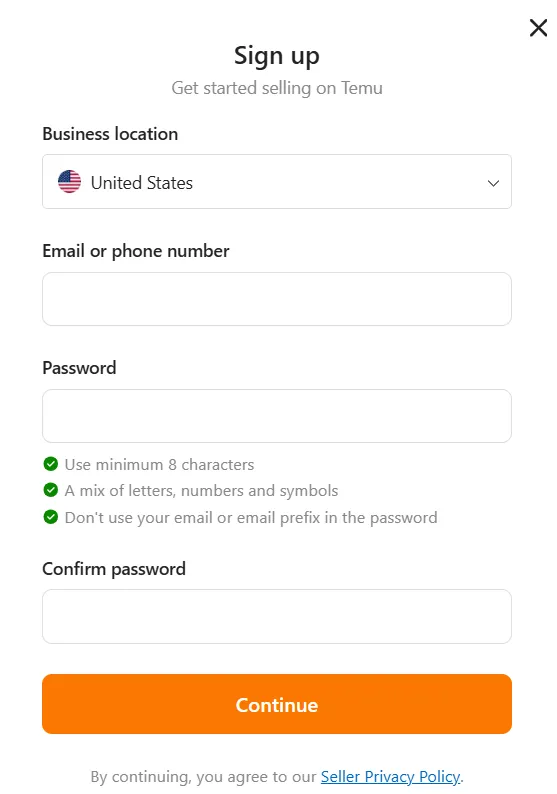
Then, Temu will send you a verification email. Check it out and finish your registration.
How Much Does It Cost to Sell on Temu [2026 Update]
Temu seller fees range from 2% to 5% per sale. Compared to platforms like Amazon, Walmart, or Etsy, where total fees can reach 15% or more, Temu offers a low-cost way to enter or expand in the US market, especially if you’re a small to mid-sized brand.
If you’re wondering how to sell on Temu profitably, understanding the fee structure is essential. While Temu doesn’t charge listing fees or subscription costs, there are still a few important factors to plan for.
Here are the key Temu seller fees you should be aware of:
Fee type | Details |
Listing fee | $0. Temu does not charge any fees for listing products on their platform |
Commission fee | 0%. Temu does not charge a commission on sales |
Referral fees | On each sale, Temu charges a referral fee which typically ranges from 2% to 5% of the sale price. |
Subscription fee | Temu does not publicly list any standard subscription fees. In most cases, sellers aren’t charged monthly fees. However, specific terms may differ based on your business size and the type of partnership you have with Temu. |
Payment processing fees | For payment processing, Temu exclusively uses PayPal, which incurs a fee of 2.9% + $0.30 for every transaction. |
Fulfillment fees | If you choose to use Temu direct fulfillment, you will be charged fulfillment fees based on the size and weight of your items. |
Shipping fees | While customers enjoy free standard shipping, sellers are responsible for covering these costs, which can vary based on the size and weight of the products. |
You may also like: What is Temu? And Why Is It So Popular?
How to Sell on Temu: 5-Step Guide
Now that we’ve gone over the requirements & registration and the cost associated with selling on Temu.
Let’s dive into the comprehensive guide on how to sell on Temu.
Step 1: Set up your seller profile
To get started, you must complete your profile.
- Enter your business information: business type, business name, Employer Identification Number (EIN), and registered business address
- Provide seller information: Primary contact’s role within the business, full legal name, valid ID (passport or driver’s license), etc.
- Set up your store details: store name, store logo, contact information
- Upload documents and complete facial verification
- Add your tax information
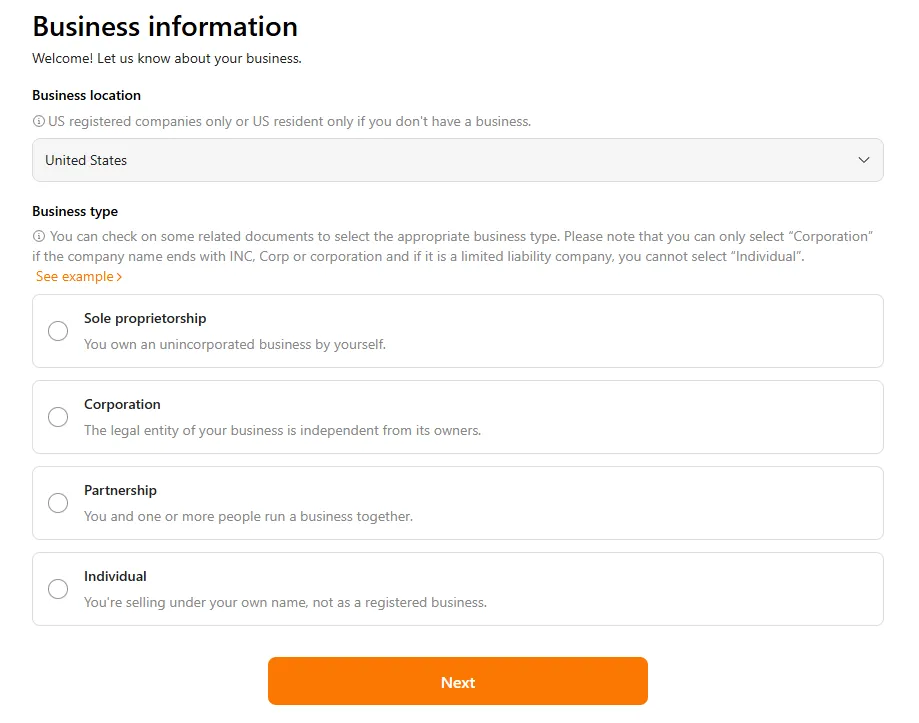
Once you’ve completed the verification process and provided the necessary details, your store entity will be submitted for review. This review typically takes about one day.
Step 2: Create your product listings
Now that your seller profile is complete, the next step on how to sell on Temu is listing your products. Head over to the Manage Products > Add Products section in your seller dashboard.
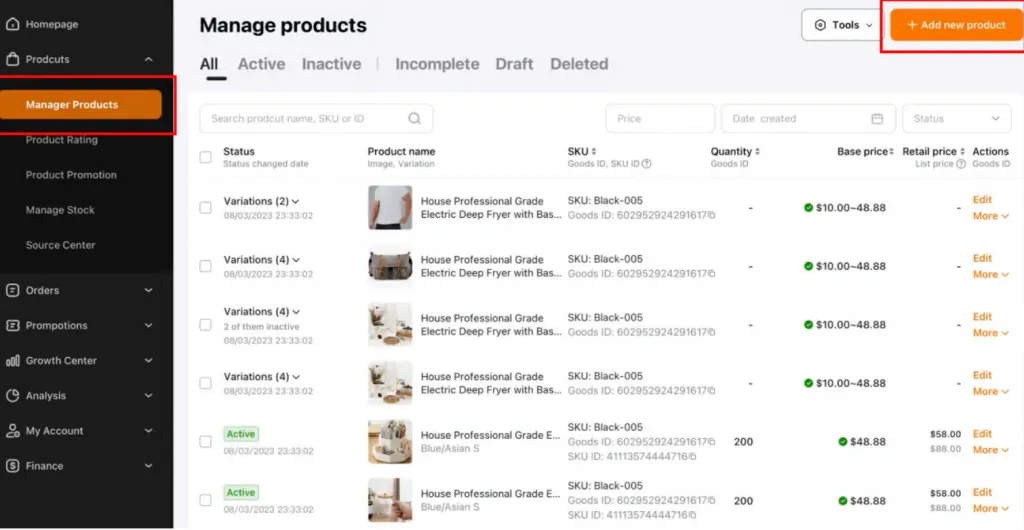
Adding products on Temu is a breeze. Before you begin, make sure you have the following information ready:
- Product title and description: Create a catchy product name and an engaging description that highlights your product’s features, specifications, and potential uses.
- Product category: Choose the most relevant category for your product from Temu’s classification system.
- Product images and videos: Use high-quality photos and videos to make your product shine for potential buyers. Temu allows up to 8 product images and videos and lifestyle photos are encouraged.
- Pricing: Ensure to price your products competitively, as Temu is known for its great discounts and low prices.
- Product quantity (inventory): Set the stock quantity for your product, and don’t worry, Temu will automatically adjust this number as you make sales.
- Product weight and dimensions: Finally, enter your product’s weight and dimensions to ensure accurate shipping calculations.
If you’re selling across other platforms like Shopify, WooCommerce, Amazon, etc. you can import them to Temu directly through a third party tool like LitCommerce multichannel selling tool. Especially if you’re handling hundreds to thousands of SKUs, manually uploading can cost you tons of time and effort.
Just let LitCommerce do the heavy lifting and focus on your growth! You can start it for free, or contact the support team for further details.
Sell Your Products on Multiple Platforms
Grab your business scaling opportunity by going multi-channels with LitCommerce. Inventory, prices, and orders will be synced in real-time, all in one dashboard.
Step 3: Set up shipping templates
Once your product has reached your customers and they decide to purchase your items, the final step in their journey of how to sell on Temu involves selecting a shipping option and completing the transaction.
To start fulfilling orders, you’ll need to create a shipping template that defines where you ship, how long it takes.
1. Go to My Account > Shipping Settings
2. Click “Add template”
You need to fill in the required fields:
- Template name
- Shipping address (this is your origin address)
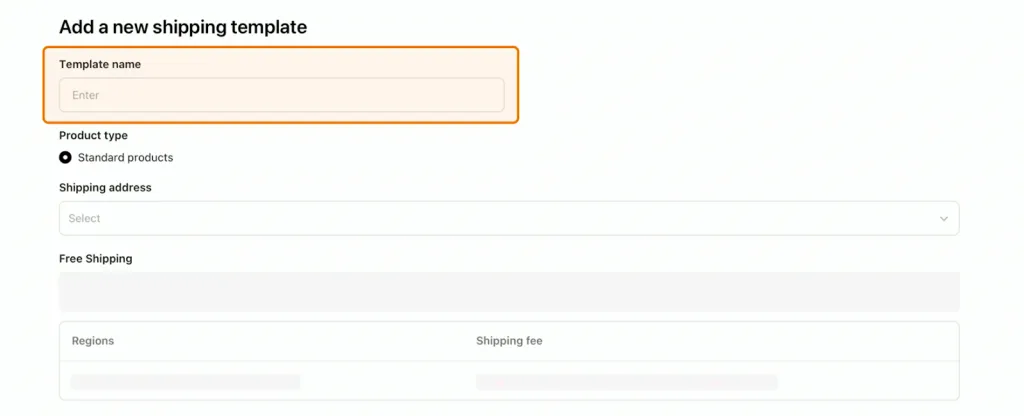
Next, you can choose whether to confirm your free shipping settings.
By enabling this option, you agree to cover all shipping costs for orders where the total retail price exceeds $30. Additionally, you commit to delivering to any valid address within your defined shipping regions, as specified in your shipping template.
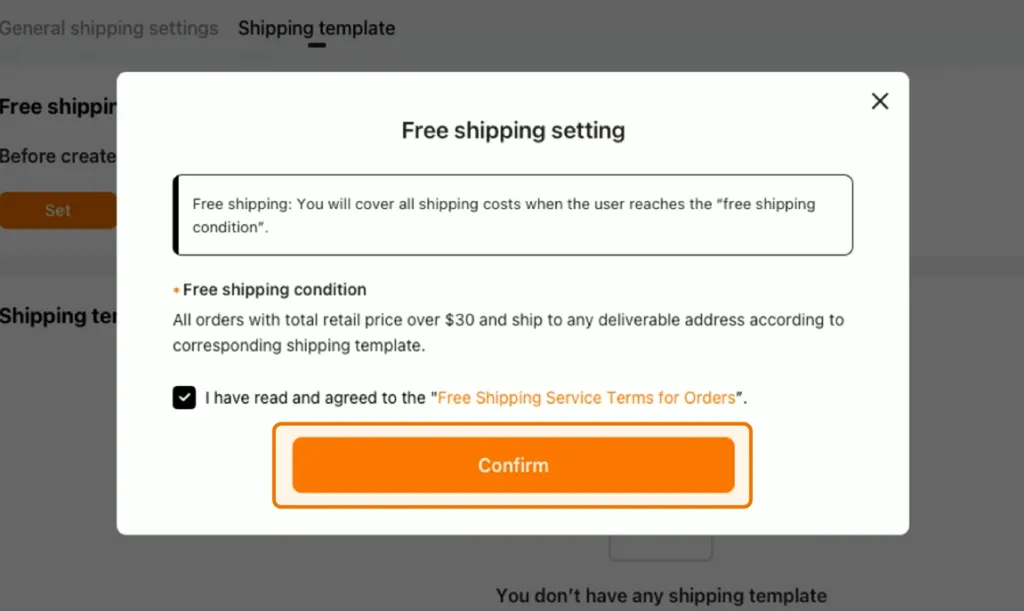
Then, you’ll need to define your shipping zones and set accurate transit times.
It’s important to be as precise as possible, as delivery speed plays a key role in customer satisfaction and shapes buyer expectations.
If your delivery times vary by region, consider creating separate shipping templates for each area to ensure accurate fulfillment and avoid potential delays.
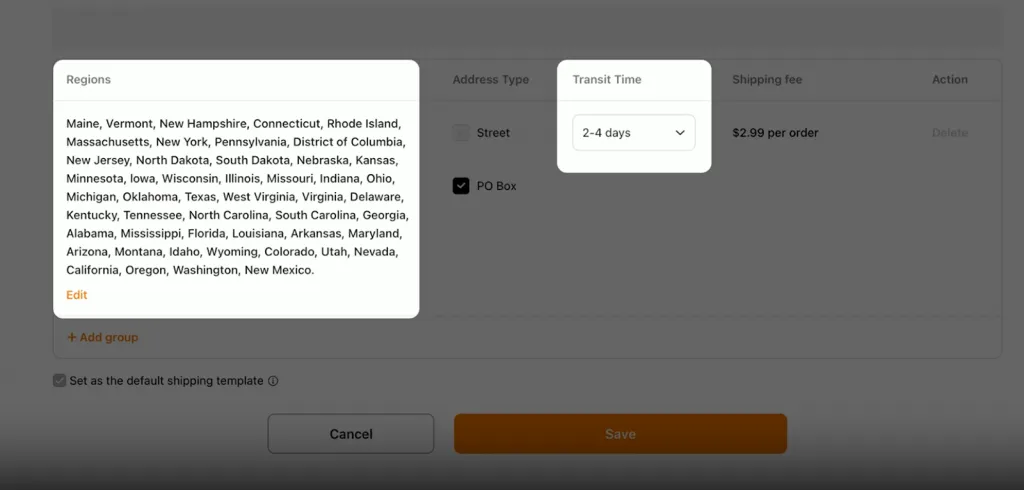
Once everything is filled in, Temu will automatically calculate the applicable shipping fee based on your inputs.
Step 4: Manage orders
To view and manage your orders, head to the “Manage Orders” page in your seller dashboard. Here, you’ll find a full overview of all order statuses, including:
- Pending
- Unshipped
- Shipped
- Canceled
You’ll also see any orders that require your attention, such as:
- Overdue shipments
- Suspected logistics issues
- Failed shipping label purchases
- And more
From this page, you can take direct action on each order to keep your fulfillment process running smoothly.
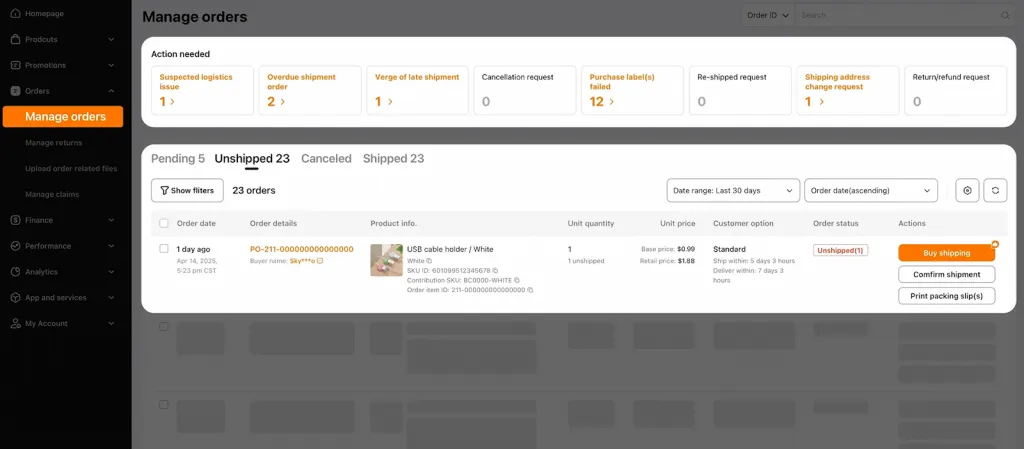
You may also like: Temu vs Amazon: What Platform Should Sellers Choose?
Step 5: Marketing your Temu shop
To reach more potential customers and boost your sales, you must think of marketing. Here are some of the key trends you should implement into your Temu marketing strategy.
Strategy 1: Leverage Temu display ads
Temu offers a variety of marketing tools to help you promote your store and products. Using Temu’s advertising options, you can increase the visibility of your items in search results.
Two main types of Temu ads are sponsored products and sponsored brands. These determine how and where your ads appear.
Sponsored product
These ads focus on individual products and appear on Temu’s search and product pages. They can even show up as alternatives to competing products, especially useful if your competitors have lower ratings or higher prices. You should consider allocating around 80% of your ad budget to sponsored products, as they tend to be more scalable compared to other ad types.
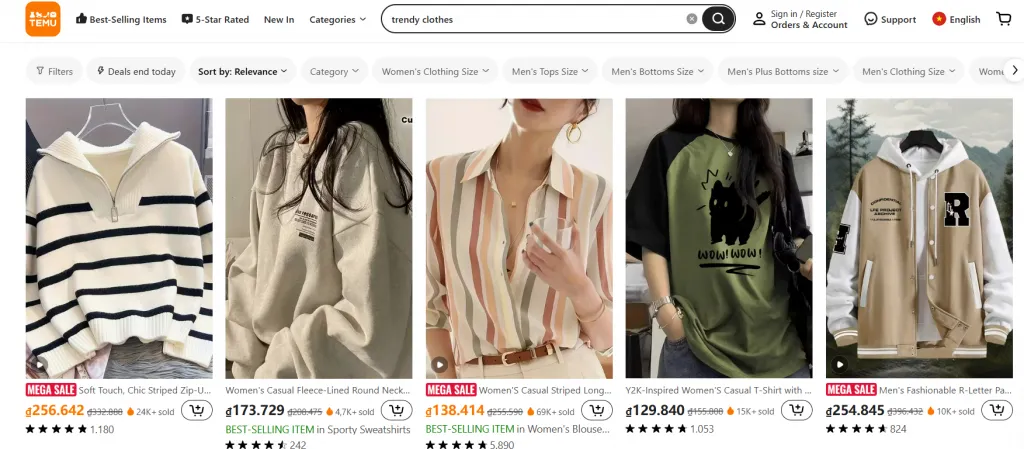
Sponsored brands
Formerly known as headline search ads, these allow you to showcase your logo, a custom headline, and multiple products. For example, if you sell clothing, you can use sponsored brand ads to highlight your entire catalog with engaging text, images, and videos instead of just advertising a single item like a jacket. This type of ad is great for sellers who have seen a decent return on investment with sponsored products and want to enhance their brand authority and awareness in their niche.
No matter which ad type you choose, here are 4 tips to help you maximize your return on investment:
Strategy 2: Utilize off-Temu traffic
Outside of Temu, there are several other advertising platforms at your disposal: Google and social media sites like Facebook, Instagram, Twitter, and TikTok, among others.
Google Ads
Google Ads mainly consist of text and keywords, similar to Temu sponsored products ads. There are various campaign types, but we’ll focus on Google Search Ads (formerly Google AdWords), which are easy to set up and can drive high-intent traffic to your Temu store.
As Google Ads costs rise each year, sellers need to use optimization tactics to keep CPC (cost per click) low. This involves creating ads that align well with what users are searching for.

Social media
Social media is also a great way to drive traffic to Temu for several reasons. With over 5.17 billion users worldwide as of July 2024, these platforms offer brands a huge opportunity to connect with potential customers outside of Temu.
You can target specific demographics, interests, and behaviors using Facebook, Instagram, TikTok, YouTube, and other social media platforms. With advertising campaigns tailored to each platform, you can effectively drive traffic to your brand’s product listings on Temu.
How New US Tariff Changes Affect Temu Sellers?
As of late 2024, the “de minimis” exemption, which previously allowed duty-free US imports under $800, was closed for shipments from China. This closure introduced steep tariffs, including:
- Flat fees of $100–$200 per shipment
- Or tariffs up to 120%, depending on the product category
Learning how to become a seller on Temu, you must acknowledge that for Temu, this policy shift disrupted a business model that relied heavily on low-cost, small-package shipping from China. In response, prices on Chinese-sourced products surged, and Temu officially ended direct-to-consumer shipping from China.
Temu has quickly pivoted by shifting to a local fulfillment model:
- Products are now bulk-shipped to US warehouses, reducing per-unit tariff costs through economies of scale.
- The platform has ramped up its onboarding of US-based sellers and brands, offering incentives like low selling fees, fast onboarding, and listing support.
- Temu continues to source many items from China but fulfills orders domestically, reducing friction with US customs and maintaining competitive delivery times.
This localization strategy helps Temu remain price-competitive while complying with new tariff regulations.

So if you’re a US-based seller, this is a major opportunity:
- Local sellers now have a competitive edge in search rankings, shipping times, and customer trust.
- Temu is actively recruiting American businesses and brands, offering increased visibility and account support.
If you’re an overseas seller, however:
- You’ll need to partner with US 3PL providers or store inventory in American warehouses.
- Expect higher operational costs due to warehousing, shipping, and tariff-related compliance.
In either case, sellers may need to adjust pricing strategies to maintain profitability while absorbing the added costs of tariffs or domestic fulfillment.
If you’re a seller ready to pivot with the platform, now is the time to take advantage of Temu’s focus on US fulfillment, localized inventory, and growing American customer base.
6 Tips to Succeed at Selling on Temu
After you know the answer to how to sell on Temu, there’s still a lot to do to keep your business thriving and profitable. Here are some expert tips to help you succeed after your launch.
Tip 1: Research winning products
Before you begin your research, it’s essential to answer these critical questions:
- Who is your target audience?
- What products are trending on Temu?
- What are the popular product categories on Temu?
- What are the average price ranges for products in your niche?
Here are two top strategies you can implement:
- Using the Temu search bar and pay attention to auto-suggestions to discover popular keywords and search trends.
- Checking out the Temu best selling items page to see what’s performing well.
Also, don’t just look at what’s selling. Study how top sellers present their listings. Pay attention to product images, titles, descriptions, and bundled offers.
You may also like: Can I Resell Temu Products? Step-by-steps Guide for Sellers
Tip 2: Develop a smart pricing strategies
Temu’s secret sauce for competing with giants like Amazon and Walmart is its incredibly low prices. To help sellers develop effective pricing strategies that meet various product and market needs, Temu offers a range of methods:
- Dynamic pricing: Temu adjusts product prices in real-time based on demand, competition, and customer behavior to help you stay competitive effortlessly.
- Temporary offers and discounts: This method focuses on using flash sales and other time-limited promotions to draw in customers and boost sales during specific periods.
- Free shipping pricing: Temu also offers free shipping pricing to make it more appealing for customers who prefer free shipping. In this case, sellers often incorporate shipping costs into their product price.

What’s more, having worked in the eCommerce industry for many years and being familiar with a number of marketplaces like Amazon, eBay, and Temu…, we’ve compiled 3 common strategies in this field as well as on Temu to pricing your product:
- Low pricing strategy: Set prices lower than competitors to attract bargain hunters. However, be cautious about your profit margins and ensure your prices are attractive yet still profitable.
- High pricing strategy: Position your products as premium by pricing them higher than competitors. This can convey exclusivity and quality, but make sure you have the features to back it up.
- Competitive pricing strategy: Match your prices with those of direct competitors to attract price-conscious customers without sacrificing profit margins.
Tip 3: Optimize your listings for search
As Temu operates on a search-driven model, it’s important to optimize your product listings.
Make sure to:
- Use relevant keywords in your titles, bullet points, and descriptions.
- Write a copy that speaks directly to your customers’ needs, pain points, or desires.
- Upload high-quality images and lifestyle photos that show your product in action.
- If possible, include short product videos.
A well-optimized listing not only boosts discoverability but also improves conversion rates.
Tip 4: Plan your inventory and fulfillment strategy
Effective inventory management is key to ensuring you don’t run out of stock or have excess inventory, both of which can impact your sales and search rankings on Temu.
Decide if you’ll handle order fulfillment yourself, it can streamline shipping and customer service, but keep in mind that it may come with extra costs.
Tip 5: Engage with customers & encourage reviews
Providing outstanding customer service is essential. Respond promptly to customer inquiries and concerns. Friendly and timely communication can lead to positive experiences and repeat business.
Tip 6: Stay updated and innovate
Keep an eye on any changes in Temu’s policies, algorithms, and trends that could impact your business. Hence, being adaptable and adjusting your strategies is key.
Look for creative ways to stand out in your niche, whether it’s through unique packaging, promotions, social media engagement or influencer partnerships.
Start Selling on Temu – FAST&EASY!
Already selling on Shopify, WooCommerce, or another platform? With LitCommerce, you can list products from your store to Temu in minutes – and start selling more today!
How to Sell on Temu – FAQs
Can I sell on Temu?
Yes. Temu is a global eCommerce platform that welcomes both individuals and businesses to sell a diverse range of products to customers around the world. Getting started is easy. Simply create a seller account, and you’ll be on your way.
How to sell on temu for free?
Temu doesn’t charge any listing fees, subscription fees, or commissions for most sellers. You can sign up, list products, and start selling with zero upfront cost.
What types of products are sold on Temu?
Temu offers a wide variety of products: fashion items, home goods, electronics, beauty products, and handmade crafts at competitive prices.
Kickstart Your Store’s Success on Temu Today!
For Temu beginners, starting your own business can feel a bit overwhelming. With our guide on how to sell on Temu, we’ve provided you with the key steps to start earning money.
One final tip is to ensure to prepare for those sales spikes during key holiday periods. You don’t want to run out of your best-selling products when customers are eager to buy. If you have any questions along the way, feel free to reach out to LitCommerce for assistance. Alternatively, you can explore a variety of eCommerce blog articles to help your business thrive.

